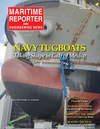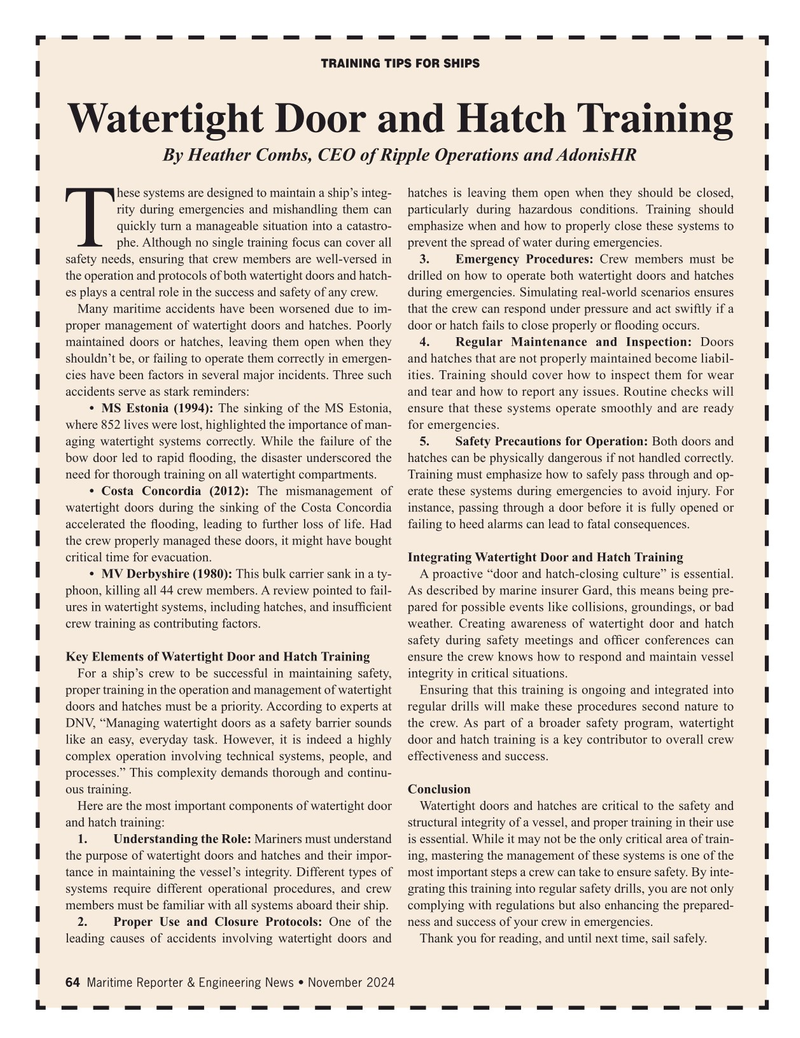
Page 64: of Maritime Reporter Magazine (November 2024)
Read this page in Pdf, Flash or Html5 edition of November 2024 Maritime Reporter Magazine
TRAINING TIPS FOR SHIPS
Watertight Door and Hatch Training
By Heather Combs, CEO of Ripple Operations and AdonisHR hese systems are designed to maintain a ship’s integ- hatches is leaving them open when they should be closed, rity during emergencies and mishandling them can particularly during hazardous conditions. Training should quickly turn a manageable situation into a catastro- emphasize when and how to properly close these systems to
Tphe. Although no single training focus can cover all prevent the spread of water during emergencies.
safety needs, ensuring that crew members are well-versed in 3. Emergency Procedures: Crew members must be the operation and protocols of both watertight doors and hatch- drilled on how to operate both watertight doors and hatches es plays a central role in the success and safety of any crew. during emergencies. Simulating real-world scenarios ensures
Many maritime accidents have been worsened due to im- that the crew can respond under pressure and act swiftly if a proper management of watertight doors and hatches. Poorly door or hatch fails to close properly or ? ooding occurs.
maintained doors or hatches, leaving them open when they 4. Regular Maintenance and Inspection: Doors shouldn’t be, or failing to operate them correctly in emergen- and hatches that are not properly maintained become liabil- cies have been factors in several major incidents. Three such ities. Training should cover how to inspect them for wear accidents serve as stark reminders: and tear and how to report any issues. Routine checks will • MS Estonia (1994): The sinking of the MS Estonia, ensure that these systems operate smoothly and are ready where 852 lives were lost, highlighted the importance of man- for emergencies.
aging watertight systems correctly. While the failure of the 5. Safety Precautions for Operation: Both doors and bow door led to rapid ? ooding, the disaster underscored the hatches can be physically dangerous if not handled correctly. need for thorough training on all watertight compartments. Training must emphasize how to safely pass through and op- • Costa Concordia (2012): The mismanagement of erate these systems during emergencies to avoid injury. For watertight doors during the sinking of the Costa Concordia instance, passing through a door before it is fully opened or accelerated the ? ooding, leading to further loss of life. Had failing to heed alarms can lead to fatal consequences.
the crew properly managed these doors, it might have bought critical time for evacuation. Integrating Watertight Door and Hatch Training • MV Derbyshire (1980): This bulk carrier sank in a ty- A proactive “door and hatch-closing culture” is essential. phoon, killing all 44 crew members. A review pointed to fail- As described by marine insurer Gard, this means being pre- ures in watertight systems, including hatches, and insuf? cient pared for possible events like collisions, groundings, or bad crew training as contributing factors. weather. Creating awareness of watertight door and hatch safety during safety meetings and of? cer conferences can
Key Elements of Watertight Door and Hatch Training ensure the crew knows how to respond and maintain vessel
For a ship’s crew to be successful in maintaining safety, integrity in critical situations.
proper training in the operation and management of watertight Ensuring that this training is ongoing and integrated into doors and hatches must be a priority. According to experts at regular drills will make these procedures second nature to
DNV, “Managing watertight doors as a safety barrier sounds the crew. As part of a broader safety program, watertight like an easy, everyday task. However, it is indeed a highly door and hatch training is a key contributor to overall crew complex operation involving technical systems, people, and effectiveness and success.
processes.” This complexity demands thorough and continu- ous training. Conclusion
Here are the most important components of watertight door Watertight doors and hatches are critical to the safety and and hatch training: structural integrity of a vessel, and proper training in their use 1. Understanding the Role: Mariners must understand is essential. While it may not be the only critical area of train- the purpose of watertight doors and hatches and their impor- ing, mastering the management of these systems is one of the tance in maintaining the vessel’s integrity. Different types of most important steps a crew can take to ensure safety. By inte- systems require different operational procedures, and crew grating this training into regular safety drills, you are not only members must be familiar with all systems aboard their ship. complying with regulations but also enhancing the prepared- 2. Proper Use and Closure Protocols: One of the ness and success of your crew in emergencies.
leading causes of accidents involving watertight doors and Thank you for reading, and until next time, sail safely.
64 Maritime Reporter & Engineering News • November 2024
MR #11 (50-65).indd 64 10/25/2024 2:57:29 PM

 63
63

 65
65
